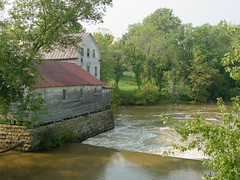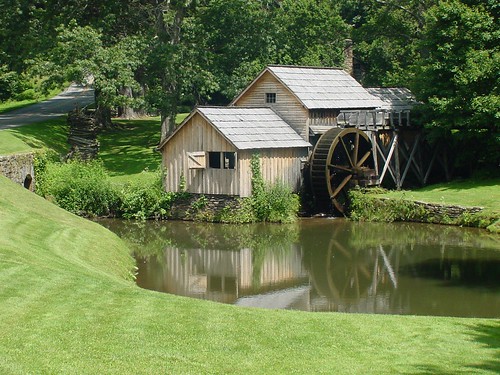Monday, December 18, 2006
Waterwheel
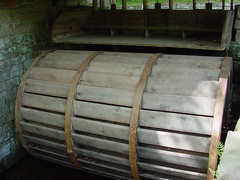
Waterwheel
Originally uploaded by vince_dinoto.
Many old mills have waterwheels that are no longer functional. This wheel at one time powered the mill but has not had water on it for sometime and no longer is functional.
Posted by
Vince DiNoto
at
11:57 AM
0
comments
![]()
Thursday, November 30, 2006
Pigeon Forge Mill - Tennessee
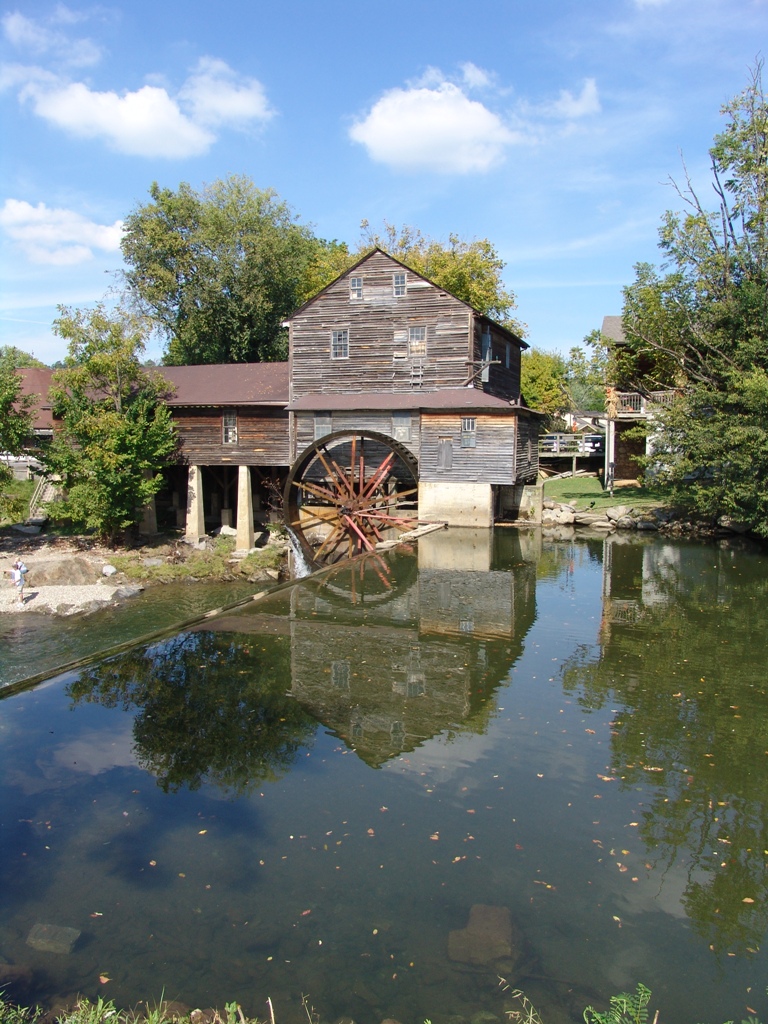 The Old Mill at Pigeon Forge is one of the most photographed mills in the country. It is located north of the Smokey Mountain National Park and one block east of the main road in
The Old Mill at Pigeon Forge is one of the most photographed mills in the country. It is located north of the Smokey Mountain National Park and one block east of the main road in 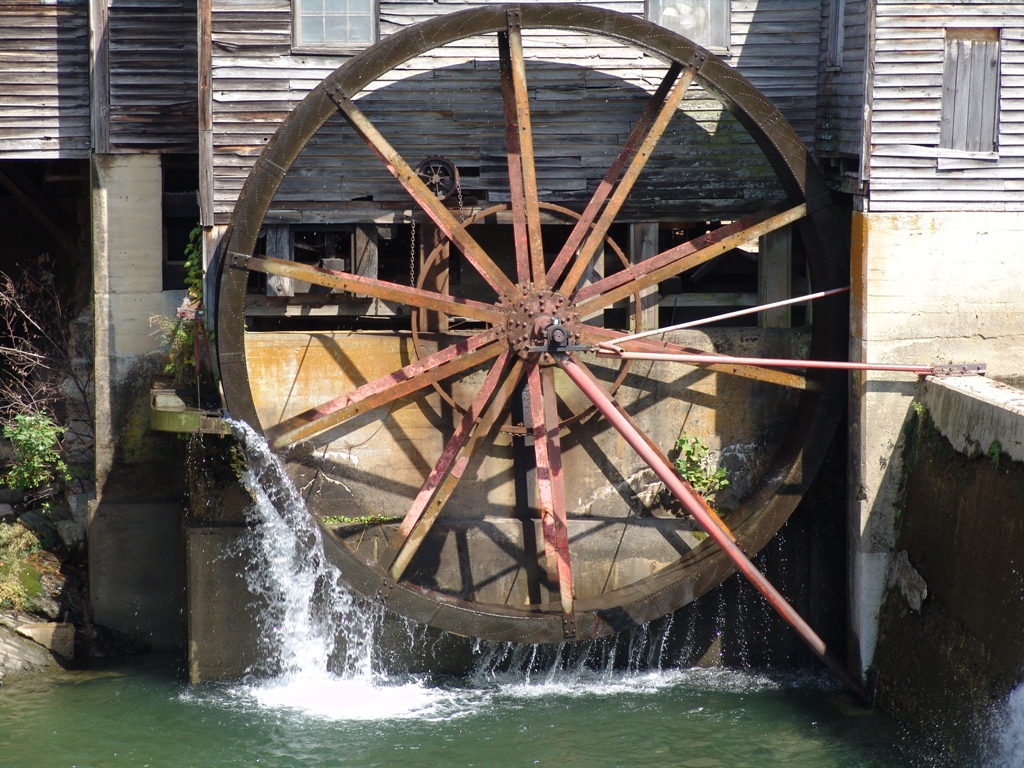 Pigeon Forge. The mill has a unique breast shot water wheel design. On most breast shot mills the water strikes the wheel from the front side. At Pigeon Forge the water strikes the wheel from the
Pigeon Forge. The mill has a unique breast shot water wheel design. On most breast shot mills the water strikes the wheel from the front side. At Pigeon Forge the water strikes the wheel from the 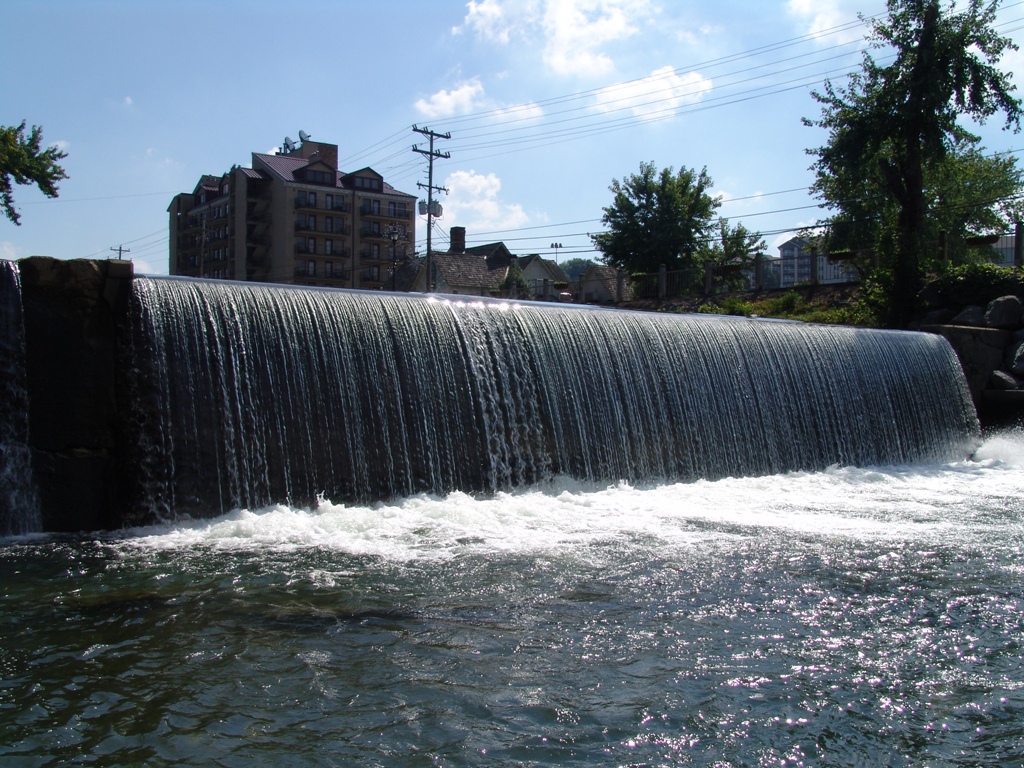 backside. The water for the mill is stored behind a dam, to provide both elevation and storage capacity. During the summer months water will not flow over the dam during low water times. These photographs were taken in the fall. For a map http://www.flickr.com/photos/91501806@N00/sets/72157594189752895/map/.
backside. The water for the mill is stored behind a dam, to provide both elevation and storage capacity. During the summer months water will not flow over the dam during low water times. These photographs were taken in the fall. For a map http://www.flickr.com/photos/91501806@N00/sets/72157594189752895/map/.
Posted by
Vince DiNoto
at
10:41 AM
0
comments
![]()
Sunday, September 24, 2006
Gaston Mill
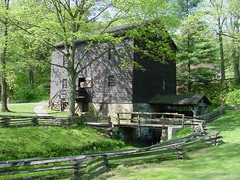
Gaston Mill
Originally uploaded by vince_dinoto.
Gaston Mill is located in Little Beaver Creek State Park. It is located near a lock on the old Sandy and Beaver Canal. http://fpw.isoc.net/KREK/Columbiana_Gastons_Mill_Page.htm
Posted by
Vince DiNoto
at
10:55 PM
0
comments
![]()
Tuesday, September 19, 2006
Steers Mill
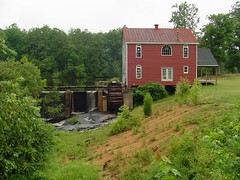
Steers Mill
Originally uploaded by vince_dinoto.
The mill was being restored when visited.
It is located in Virginia south of Richmond.
Posted by
Vince DiNoto
at
7:34 PM
0
comments
![]()
Sunday, September 17, 2006
Wayside Inn Mill
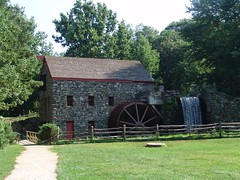
Wayside Inn Mill
Originally uploaded by vince_dinoto.
The Wayside Inn Mill was built by Henry Ford. It is one of the most photgraphed mills in the country. It is located west of Boston, MA.
Posted by
Vince DiNoto
at
5:01 PM
0
comments
![]()
Link to Mill Map
This link will provide a map of mills and photographs taken of the mill.
Posted by
Vince DiNoto
at
4:35 PM
0
comments
![]()
Haywood Mill
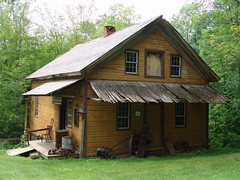
Haywood Mill
Originally uploaded by vince_dinoto.
This mill is located in New York state north of Albany and east of the Hudson River. It is also known as the Log VIllage Grist Mill.
Posted by
Vince DiNoto
at
4:14 PM
0
comments
![]()
Mabry Mill
Mabry Mill is located on the Blue Ridge Parkway.
Posted by
Vince DiNoto
at
3:56 PM
0
comments
![]()
Monday, September 11, 2006
Digital Cameras
This article is a draft of an article that may be submitted ot Old Mill News.
While most of the articles in Old Mill News deal with old mills or pieces of equipment and how they function. This article will deal with a side of mills that many of us do which is the photograph of the mill structure and equipment. Many of us began our photographing of old mills using a 35mm SLR (single lens reflex) camera, others have used a more simple point and shoot camera including disposable cameras. With the digital camera coming of age many of us have either purchased or considering the purchase of a camera and understanding the specifications can be confusing. I have also discovered many who made purchases of digital cameras have not been pleased with the results. In this article I will try to explain the specifications of digital cameras and try to help you understand the many choices that you must make in deciding on the proper camera.
First you must have a clear understanding what you want to do with the camera; this is before looking at stores or ads. Without this understanding it is very likely that you might purchase the wrong camera. Some of the questions that need to be answered are:
--What will you do with the pictures you take?
--Are you going to print the pictures?
--View them on a computer screen?
--If you plan to print your pictures than you must decide what size is the maximum size you believe that you will print pictures to be.
If you will display your pictures on a computer screen than a low end camera will meet your needs most likely. If you will be printing your pictures no larger than 4 inches by 5 inches than again the expense of the camera can be minimized; but if you plan to print pictures 8 inches by 10 inches, 8.5 inches by 11 inches, 11 inches by 17 inches or bigger than the expenses will greatly increase. Also if most of your pictures will be of the outside of mills the expense is much less than if you plan on taking lots of interior pictures. The size the image can be enlarged to is based upon two major factors; the number pixels (picture elements) contained within the image and the quality of the lens.
If the purpose of the camera for mill photograph is to take outdoor pictures that will be displayed on a computer screen, the camera should have between 3.1 and 5 megapixels (a megapixel is the number of dots in the image, mega meaning a million), a moderate zoom lens of 3x to 5x optical zoom (never look at the digital zoom when purchasing or using a camera, most cameras that have digital zoom can be turned off and I would highly recommend doing this). This type of camera will also work fine for printing pictures no larger than 4 x 5 inches. These cameras can usually be purchased for less than $200, there are lots of brands to choose from but these are the major features, except the type of media (memory) that the camera uses. There are lots of different formats, Compact Flash (CF), Secure Digital (SD), Memory Stick (two formats, only in Sony Cameras), and many others but these are the three types I recommend, because they are easy to find in discount stores for purchase. Think of the memory chips as different brands of film. Your camera you should also have a USB II connector for connection to your computer. Rechargeable batteries are nice but not a luxury that you must have and in some ways they can be more of a problem on the lower end cameras, because you can always carry a second set of disposable batteries, but you might not have another set of rechargeable batteries and in some cameras the rechargeable batteries cannot be removed. If you plan on taking lots of indoor pictures of mills than I would suggest a higher end camera even if you still are going to display them on your computer. You should use an external flash instead of the built in flash for two reasons, the flash is a real energy drain on your camera batteries and they are usually not bright enough to illuminate the interior of the mill, I would suggest the middle end camera that will be discussed next if interior pictures are you interests. If your camera has a view finder use it instead of the display as this will extend the life of your batteries and the number of pictures you can take, always have your camera set on the highest quality settings as you can always make images smaller, but never improve the quality of the picture.
For those who plan on printing larger pictures, better lenses are needed on the camera and also in general more megapixels. These cameras are very easy to spot in the stores because the lenses on the camera are usually much larger. When you look through the viewfinder you usually are looking through the lens. Yet the lenses are not removable. The megapixel range will vary from 5 to 10 on these cameras. The optical zoom is usually greater than on the previous class of cameras. The expenses of these cameras usually range between $300 and $1000. The media formats are the same as what was discussed earlier. On most of these cameras you can control the shutter speed and the size of the aperture (the opening of the lens), therefore you can experiment with depth of field (the smaller the aperture the more of the image is in focus). This also gives you the ability to stop moving objects like the waterwheel or water falling from the mill dam. These cameras usually have a hot shoe to place an external flash on the camera that will be controlled by the camera, make sure the flash that you purchase separately is compatible with the camera. An 8 megapixel camera is excellent for making a picture as large as 13 x 19 inches.
The final class of cameras are the SLR cameras, the lens will be removable on these cameras and most are manufactured by the traditional camera manufactures (Note Sony has purchased Minolta and they are bringing out a new line of cameras under the Sony name, but they are related to the Minolta cameras). These cameras start at around $500 and upwards of several thousands of dollars. The lenses can be equally expensive. They usually have between 6 and 12 megapixels (cameras for this holiday season have yet to arrive and they may be even greater). One of the features is the ability to take pictures very rapidly, such as 3 to 6 pictures per second. The clarity of the images is better due to the better optics of the cameras, making better enlargements.
There are many ways to get your pictures printed many companies now allow you to upload your pictures via of the internet. Most local stories that print pictures also have computers that can read your memory chip or attach via your USB cable. Note: not all USB cables work on all cameras therefore always keep your cable with your camera. Printing pictures at home is a nice convenience but in general costs many times more than taking it to the store, this includes the small photo printers and the larger computer inkjet printers. Yet the prints that can come from modest price inkjet printers using photographic quality glossy paper can be better than what can be printed at a camera store. I can print pictures in the thousands of dots per inch, but the local camera story prints only up to 300 dots per inch. If you wish to display your pictures online, there are many free or very inexpensive services that will allow for your pictures to be displayed, you need to carefully research the maximum size of the upload picture. I have placed many of my pictures on Flickr.com and they have a group for historical mills. This service gives you a limited amount of upload space free per month or at a modest cost a very large amount of upload space each month.
Film cameras and digital cameras have now reached a point of equality, as long you stay within the specifications of the camera, a cheap film camera would not have made a very good 8 x 10 and neither does a cheap digital camera. Effective use of your digital cameras and video cameras are another whole topic beyond the scope of this article and will be discussed in a future article. I now take nearly all of my pictures digitally.
Posted by
Vince DiNoto
at
10:51 AM
0
comments
![]()
Thursday, September 07, 2006
Using a GPS to Discover Old Mills
How often have you been looking for an old mill and know you have to be very close but you just can’t located. I know in my searches this has happened numerous times. When I first started looking for old mills more than 20 years ago, I would purchase map books of a state which would have detailed county maps (these books are still available). Before going milling I would take the SPOOM (Society for the Preservation of Old Mills) mill list (The mill lists provide directions to mills and are usually very accurate.) and try to plot the location of the mills I was hoping to visit. Generally I was able to locate the mill that I was wishing to photograph, but several times I just could not find the mill. With the technological improvements in computer technology, I started using a GPS (Global Positioning Satellite) Receiver, a laptop computer and mapping software; I also needed a power inverter to power the computer from my cigarette lighter. The first couple generations of the software was somewhat limited, the GPS took a long time to link with the computer through the serial port and the laptop computers were relatively slow compared to our current standards, so map regeneration took a few seconds. Today I use a Bluetooth wireless GPS receiver that connects to my laptop computer. I also have a hand held GPS which connects to my PDA (Personal Data Assistant) by the compact flash slot. The same software can be loaded on both my PDA and laptop. When I locate a mill I create a waypoint for the mill and potentially other components around the mill like the mill dam, race and other structures. Therefore the GPS shows my position but in general does not locate the mill for me since no one as recorded its position, but instead I use the GPS to locate the position of the mill that can be used by others. Some of the software packages will show elevations on the map and some will show the old mill ponds which can assist in the locating of the mill. For a few of the mill someone else has geocoded (latitude and longitude) the position and that can be programmed into the software and which will determine the shortest or quickest route to the mill from any starting position. Therefore, by using a GPS we can position the mill to a high degree of accuracy so that future generations will have the pleasure of locating these wonderful structures. Hopefully people will share there mill positions so that it will become easier to locate the mills, much as was done in the creation of the mill lists. SPOOM mill list do have a fields for latitude and longitude.
A GPS receiver works by measuring the time that it takes for a signal to reach the receiver from multiple satellites orbiting the earth. By knowing the time for the signal from each of the satellites to reach the receiver, the distance to each satellite (the position of these satellites are very accurately known) can be computed and by using trigonometry your position on the surface of the earth can be determined in 3D, latitude, longitude and elevation. The more satellites that the receiver can detect the more accurate your position, most GPS units will be accurate to 30 feet or less. The accuracy of the GPS is dependent on the number of satellites and number of digits of accuracy that the unit can receive. Some of the units can also detect ground stations that have a position that is known to a high degree of accuracy and can further reduce the position error. A GPS is only a receiver unless it contains a cell or satellite phone, many trucking companies utilize GPS technology and a satellite phone to determine the position of their trucks at all time. Therefore, the home office can locate every vehicle at any moment. A determination of the speed of an object can also be calculated, since the GPS is determining the position at regular interval of time, the accuracy of the speed determination can be as good as your speedometer.
If you looked at purchasing a GPS unit you know there is a whole range of devices and prices. The simplest type of GPS is the ones contained in many cell phones today (all new cell phones have a GPS), usually to utilize the GPS you must pay for a service. If you want to purchase a GPS unit there is a complete range of prices and abilities and I will try to describe some of the different types of GPS units. A completely standalone unit can be purchased and will vary in cost from a few hundred dollars to several thousand dollars depending on the abilities of the instrument. If you want a device to provide only the longitude and the latitude of your position they are relatively inexpensive. The next step-up is those GPS units that provide monochromatic maps of the region on the display. The more advanced system offer more detailed color maps. Some of these units can be connected to a computer so that you can download data and others the data must be manually recalled if you wish to plot it on a computer map. The second type of GPS utilizes as PDA like a Palm Pilot or a Dell Axiom. Maps can be loaded into PDA from a computer and can either be directly connected to the GPS via cable, PCMCIA Card, Compact Flash Slot or by Bluetooth wireless. These units are small and more expense than the low end standalone GPS, but much more flexible since they can be connected directly to a computer and maps can be upgraded as changes occur. They also retain the function of the PDA. The third method is to use a GPS either directly connected to your laptop computer by a USB cable or wireless connection. These devices are the most flexible and provide the most power to the user, but also the most expensive unless you are already have the laptop computer. Of course we also have GPS units in some cars.
With most all GPS units you have the ability to store a position and name the position that is stored, like Pierce Mill Dam. These positions are called waypoints. The position of the mill, the dam, the race can all be stored within the accuracy of the device (30 feet or less) as was discussed above. This geocoding of the position of dams can than be placed into a GIS (geographical information system) system and stored on maps that can be displayed over the internet, with roads and other major features labeled.

So instead of missing that mill that was just around the corner in the overgrown field we can find the location every time if someone provides the accurate latitude and longitude of the mill. In most GPS you can put in the position that you want to locate and it will direct you either by displaying directions and distances away from the point, or on more expensive systems it will display the roads and directions of each turn to reach the site and the upper end systems will map it for you displaying your current position, your end point, display the roads, giving directions, even speak to you when you need to turn and if you get off the road it will reroute you. Of course every once in a while the computer map is not correct, most of these maps were developed from either aircraft imagery or satellite data. I was recently searching for a mill in the Catskills in New York state and the road in which the computer told me to take to reach the mill that I had (from looking at a website) did not reach the mill, about half way up a mountain the road became a dirt path, so every once in a while technology can fail you.
For the last several years I have been geocoding the mills sites that I have visited and will be in the near future placing them on an interactive website for others to use. If anyone would like to send me the locations of mills I will be happy to add them to my data. I can be reached at vince.dinoto@kctcs.edu.
Posted by
Vince DiNoto
at
9:41 PM
0
comments
![]()
Labels: GPS
Friday, August 25, 2006
Hanford Mill
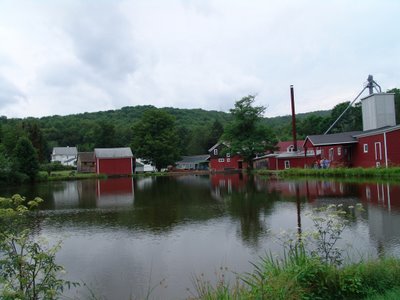 Hanford Mill in the Catskills of New York State was a water powered industry, that has been restored as a museum. The mill was not your typical sawmill that only cut lumber (which they did), but also made wooden pieces for homes and other factories such as barrel tops, trim and wooden milk boxes. In addition to the wood working equipment a grist mill was used to grind grain.
Hanford Mill in the Catskills of New York State was a water powered industry, that has been restored as a museum. The mill was not your typical sawmill that only cut lumber (which they did), but also made wooden pieces for homes and other factories such as barrel tops, trim and wooden milk boxes. In addition to the wood working equipment a grist mill was used to grind grain.
The mill had both turbines and an internal waterwheel that provided the power. Currently only the Fitz waterwheel is functioning. The mill pond located in front of the mill supplies the water to the mill complex. The water source is a small creek that runs behind and to the right side of this photograph. The mill building is the building in the center of the picture. A railroad ran to the right side of the complex at one time. The smoke stack to the right is for the steam engine. Normally waterwheels are taller than then their width, this waterwheel is a Fitz waterwheel and is much wider than the diameter. This was because of the large amount of water available from the mill pond and the small head available (vertical drop of the water).
Normally waterwheels are taller than then their width, this waterwheel is a Fitz waterwheel and is much wider than the diameter. This was because of the large amount of water available from the mill pond and the small head available (vertical drop of the water).
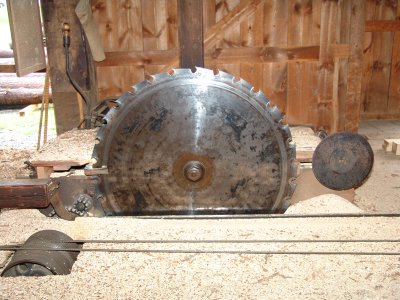 The Circular Saw was used to cut logs into boards that could either be sold or used in other parts of the mill complex. Other water powered wood working equipment is functional within the mill.
The Circular Saw was used to cut logs into boards that could either be sold or used in other parts of the mill complex. Other water powered wood working equipment is functional within the mill.These photographs were taken by Vince DiNoto in July of 2006. Their website is: http://www.hanfordmills.org/
Posted by
Vince DiNoto
at
1:25 PM
0
comments
![]()
Water Power
Water Power until the invention and utilization of the steam engine in the 1800's and before was the major source of power for early American factories. While today most of the remaining water mills are in remote areas and many times in parks, these mills were the work horses of American industry and water was used to grind grain, saw lumber and power textile mills to mention a few. Some of these larger industrial complexes still exist in the northeastern part of the country. More on this subject and pictures will be added in the near future.
Posted by
Vince DiNoto
at
12:45 PM
0
comments
![]()

